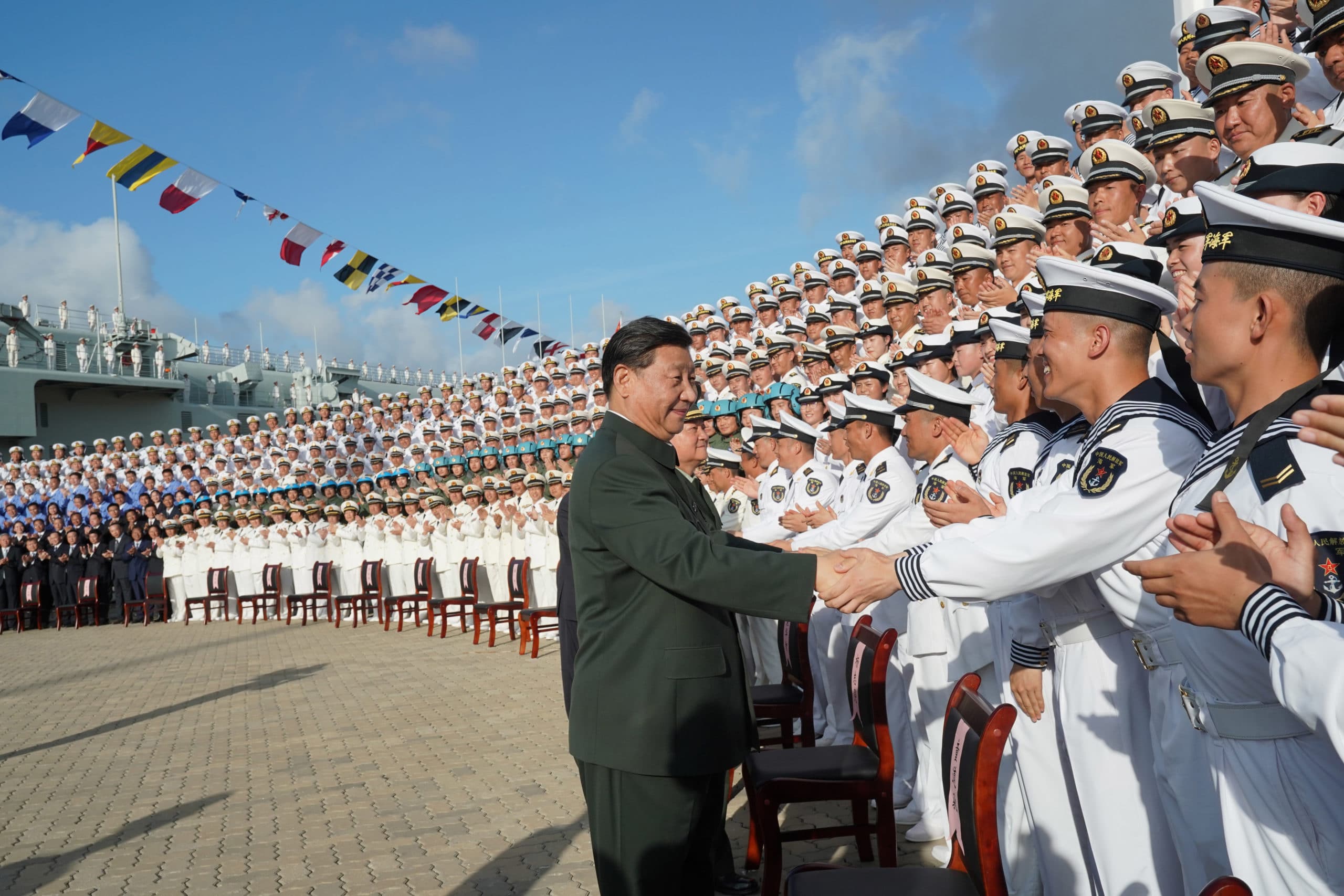December 15, 2020 | Defending Forward Monograph
China’s Military Aims
December 15, 2020 | Defending Forward Monograph
China’s Military Aims
The leading threat to U.S. interests in the Indo-Pacific is the Chinese Communist Party (CCP) and its PLA. Previously referred to as the “Red Army” under Mao Zedong, the PLA has evolved considerably from its humble beginnings as a defensive, ground-based army.1 Guided by the 2019 Chinese whitepaper “National Defense in a New Era,”2 the PLA is currently undergoing a comprehensive restructuring and modernization. The goal is to produce a capable and agile expeditionary fighting force to support President Xi Jinping’s vision for the “great rejuvenation of the Chinese nation” by 2049.3 In the intervening years, the PLA will remain focused on eliminating key capability gaps, defending China’s maximalist territorial claims, and actively undermining U.S. and allied interests in the Indo-Pacific.
Xi has broadly defined the PLA’s mission as defending China’s “sovereignty, security, and development interests.”4 These efforts have taken on a new dimension as the CCP seeks to safeguard its monopoly on power at home and its growing economic interests abroad, including its One Belt One Road (OBOR) investments. Thus, beyond simply enhancing China’s military capacity and furthering Beijing’s ability to impose its will throughout the Indo-Pacific, the PLA figures to play an important role in Xi’s principal goal of attaining great-power status and securing China’s place within the international hierarchy.
The CCP and the PLA seek to compel other countries to acquiesce to Beijing’s demands. This focus on achieving diplomatic and economic outcomes beyond a mere reduction in U.S. forces in the Indo-Pacific is a key component of China’s efforts to limit and, in some cases, eliminate U.S. military influence over other countries. Xi’s ultimate goal is to constrain the U.S. ability to rally regional partners to take measures at odds with China’s long-term interests.

Chinese President and General Secretary of the Communist Party of China Xi Jinping attends the commissioning ceremony of China’s first domestically built aircraft carrier in Sanya, on December 17, 2019. (Photo by Li Gang/Xinhua via Getty Images)
With its 13th Five-Year Plan in 2016, Beijing embarked on a campaign to strengthen its capabilities in all warfighting domains. The PLA’s estimated $261 billion-plus defense budget5 is also focused on reversing the once-heralded Chinese notion that “land must outweigh the sea.” The PLA now prioritizes a diverse set of technological capabilities throughout the Indo-Pacific.6 These include conducting joint operations on a modern battlefield, with an emphasis on expanding naval operations far beyond China’s immediate vicinity; employing integrated, real-time command and control networks to ensure rapid decision making and information sharing; enhancing China’s anti-access/area-denial capabilities; and winning “informatized” (cyber) wars. 7
China’s military modernization has been substantively aided by its study of U.S. military operations as well as the knowledge China has gained from counter-piracy, humanitarian assistance and disaster relief, and peacekeeping operations.8 The CCP’s military advancements have also been furthered by Beijing’s illicit acquisition of intellectual property and other sensitive information as part of China’s military-civil fusion strategy.9
In support of its short- and long-term goals, the PLA has prioritized the following:
- Investing in cutting-edge command, control, communications, intelligence, surveillance, and reconnaissance systems.10
- Revolutionizing and expanding China’s navy, already the world’s largest, with new, technologically advanced submarines, destroyers, amphibious ships, patrol craft, aircraft carriers, unmanned underwater vehicles, and other surface combatants.11
- Streamlining the PLA’s logistics and defense industrial base.12
- Deploying technologically sophisticated aircraft and equipment, including fourth- and fifth-generation fighter jets, long-range bombers, and transport aircraft.13
- Developing intermediate-range ballistic missiles, such as the DF-26, and hypersonic and anti-ship ballistic missiles that could threaten U.S. aircraft carriers and key U.S. bases, such as Guam.14
- Designing and deploying advanced space and offensive cyberspace assets as well as upgrading the PLA’s nuclear weapons capabilities.15
- Prioritizing non-combat mission capabilities, such as military assistance and training programs throughout the Indo-Pacific. 16
The PLA’s increasingly maximalist approach to its near abroad has roots in Chinese domestic politics and the CCP’s historical attempts to bolster its legitimacy during times of national crisis. The PLA’s posture is also driven by a desire to neutralize China’s principal threats – Taiwanese separatism and the United States. While the CCP’s efforts have taken several forms, they have clearly manifested in the PLA’s consolidation of territorial gains in the South China Sea (SCS) and Beijing’s persistent challenges to the sovereignty of its neighbors. Alarmingly, the commander of U.S. Indo-Pacific Command, Admiral Philip S. Davidson, noted in 2018 that China, as a “peer competitor,” was “capable of controlling the South China Sea in all scenarios short of war with the United States.”17
The PLA’s posture does not, however, hinge on its ability to defeat the U.S. military outright, but rather to make intervention too costly for the United States to consider. To accomplish this in the SCS, for example, the PLA has invested heavily in fortifying several of its SCS installations with anti-ship missiles, surface-to-air missile systems, and advanced jamming equipment.18 Beijing took these steps despite a tacit 2015 promise by Xi to then-President Obama that China would not militarize the area.19 This has resulted in the near-normalization of the PLA’s illegal SCS build-up and its “nine-dash line” declarations despite a unanimous 2016 ruling by the International Tribunal for the Law of the Seas rejecting Beijing’s territorial claims.20
Establishing military bases throughout the Pacific could significantly enhance the PLA’s ability to project power, though China’s dearth of military allies has historically hamstrung such efforts. China’s future efforts to build military bases in the Southern and/or Western Pacific might include attempts to leverage an initial foothold from OBOR projects in certain countries of interest, reminiscent of Beijing’s successful strategy in East Africa.21 In other cases, the PLA may seek to conclude agreements for a small number of dual-use ports and bases offering limited support for military ships and aircraft in addition to commercial vessels, under the guise of protecting China’s economic interests.22 Locations of basing interest likely include Myanmar, Thailand, Singapore, Indonesia, Pakistan, Sri Lanka, the United Arab Emirates, Kenya, the Seychelles, Tanzania, Angola, and Tajikistan, according to the U.S. Department of Defense.23
At present, the PLA lacks the ability to deploy and sustain large numbers of conventional forces globally or to persistently service ships at sea, although the PLA has supported limited conventional deployments via disaster relief and peacekeeping operations, primarily in Africa.24 The PLA Navy has also operated and deployed vessels as far away as the Indian Ocean and the Mediterranean, Baltic, and Artic seas. These missions were conducted under the auspices of naval diplomacy, with one mission in 2017 lasting nearly seven months and encompassing port calls in 20 countries, including countries in Europe.25 Additional examples of incremental PLA power projection include increasingly expansive PLA Air Force training missions beyond the first island chain and into the Western Pacific, including several exercises within 1,000 miles of Guam. These operations, many preceded by missions involving hydrographic research ships, have occurred in parallel with China’s increasingly belligerent behavior in the SCS as well as a series of provocative drills simulating the seizure of a strategic island under Taipei’s control.26
Moving forward, there are clear indications the PLA remains eager to deploy farther into the Indian Ocean and Western Pacific. Beijing will be keen to capitalize on what it perceives as a “period of strategic opportunity” – increasing its military capabilities without sparking a major conflict.27 Whereas previous PLA deployments were designed to fall below the threshold of alarming the international community or provoking the United States, future missions, particularly in the waters around Taiwan, will likely become more provocative as China seeks to assert control over disputed areas and enhance its global standing.
Although the PLA currently remains in an inferior position relative to the United States in terms of overall military strength, recent and expected gains reveal China is on track to attain great power military status much sooner than 2049. This is predicated upon degrading U.S. influence throughout the region, not simply undermining America’s military might. Paradoxically, Beijing’s attempts to constrain Washington and coerce its neighbors will likely galvanize an increasingly robust response from the United States and its regional partners. In doing so, countries in the region will be better positioned to effectively confront China’s increasingly malign behavior, thus jeopardizing Beijing’s grand strategy and possibly strengthening America’s hand in the region.
